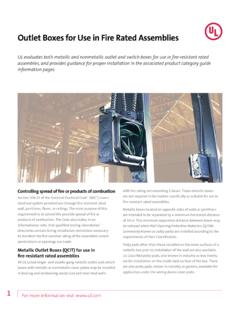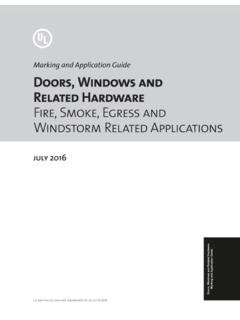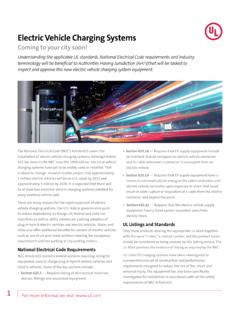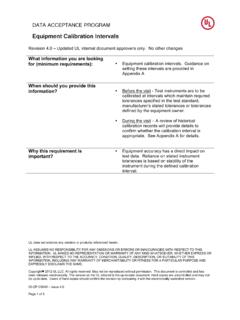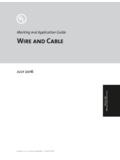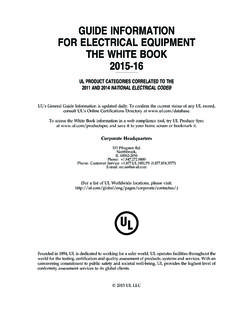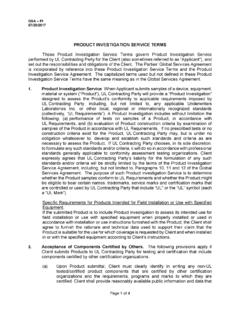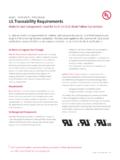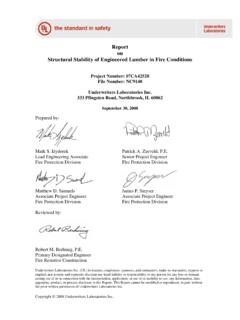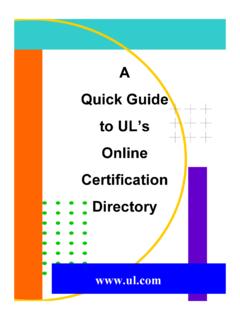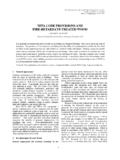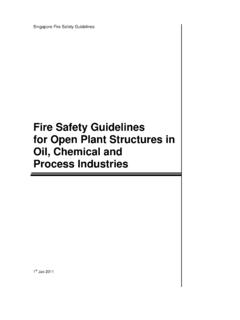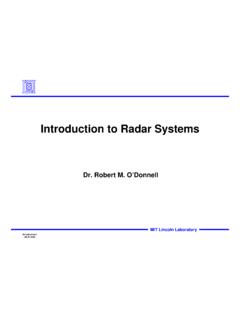Transcription of Best Practice Guide for Passive Fire Protection for ...
1 Best Practice Guide for Passive fire Protection for Structural Steelwork fire RESISTANCE AND EXTERNAL EXPOSURE CHARACTERISTICS 1st Edition: October, 2018 UL s Best Practice Guide for Passive fire Protection for Structural Steelwork 1st Edition: October, 2018 2 Contents 1. INTRODUCTION .. 4 Use of This Guide .. 4 Information on Listing versus Classification .. 6 UL Mark Considerations .. 7 UL Listing Mark .. 7 UL-EU Mark .. 7 Post Installation Inspections .. 8 Standard Industry Practices .. 8 2. CODES AND STANDARDS .. 8 Model Codes .. 8 Product Safety Standards .. 8 Installation standards .. 9 3. fire Protection PRODUCTS FOR STRUCTURAL STEELWORK .. 9 Boards .. 10 Sprays .. 10 Reactive Coatings.
2 10 4. ENVIRONMENTAL EXPOSURE CONSIDERATIONS FOR fire Protection PRODUCTS FOR STRUCTURAL STEELWORK .. 10 fire Protection PRODUCTS FOR STRUCTURAL STEELWORK SELECTION AND INSTALLATION .. 12 5. CELLULOSIC AND HYDROCARBON FIRES .. 15 Cellulosic 15 6. SPECIFIC AREAS OF GUIDANCE .. 16 Topcoats .. 16 Non-Traditional Shapes .. 17 Flat Plates.. 17 Horizontal Hollow Sections Used as Beams .. 18 Non-UL Listed Data to Top-Up/Extrapolate Beyond the Listed Data .. 18 Beam and Floor/Roof Listings (N & S, D, E, G, J, & P Series Letter Designations) .. 18 Thermal and Structural Restraint .. 19 Cellular 20 Attachments .. 20 Multi-Temperature Analysis .. 20 APPENDIX A UL CERTIFICATION PRODUCT CATEGORIES FOR STEELWORK fire Protection .
3 22 APPENDIX B GLOSSARY .. 23 UL s Best Practice Guide for Passive fire Protection for Structural Steelwork 1st Edition: October, 2018 3 PREFACE fire Protection - Building codes rely on fire Protection features to safeguard people from fire and other hazards attributed to the built environment and to provide safety to fire fighters and emergency responders during emergency operations. One aspect of this Protection is based on maintaining the structural integrity of the building during fires using a fire safety concept or engineering approach. The overall fire safety in a building includes requiring fire -resistance-rated fire walls, fire barriers, fire partitions, smoke barriers, shaft enclosures and horizontal assemblies as well as complimentary active fire protective systems to be provided to limit the spread of fire .
4 It also includes requirements designed to limit the movement of smoke and toxic gases through the building using smoke barriers and partitions. This Passive Protection is an integral part of the overall safety scheme included in the codes. An important aspect of maintaining a building s structural integrity is protecting the steelwork used to support the floors, walls, roofs and other building systems that are provided to allow the building to be functional. Various products are used to protect the steelwork such as boards, cementitious or fibrous sprays and intumescent coatings. Some of these materials have reactive properties which provide an increased level of insulation when exposed to elevated temperatures.
5 UL certifies a wide range of products that are covered by steelwork protective requirements in building codes. These products and materials, and the applications for which they are certified, are covered in detail in this Guide . Since some of the products are also certified for use during the erection process and may be exposed to weather elements or intended for long-term use in an external environment, these applications are also covered in this Guide . Boards, Sprays and Intumescent Coatings that have been certified by UL are not Listed by name or brand in this Guide ; up-to-date Listings (Certifications) can be found on UL Product iQ. UL developed this Guide for use by code and inspection authorities, architects, contractors, installers and other interested parties.
6 It is intended to aid in understanding the basic components of fire Protection for structural steelwork, in association with the applicable codes and standards to facilitate safe, code-compliant installations. UL Guides are updated as necessary due to new product developments, changes in the codes or the need for clarification. To confirm the current status of any UL Guide , please contact UL. UL 333 Pfingsten Road Northbrook, IL 60062 USA + UL s Best Practice Guide for Passive fire Protection for Structural Steelwork 1st Edition: October, 2018 4 Figure 1 Steelwork fire Protected By Intumescent Coating System (Photo Courtesy Of Sherwin-Williams) 1. INTRODUCTION Use of This Guide This Guide is intended to assist regulatory authorities, designers and installers in determining the suitability of fire protective products and systems for structural steelwork in a particular installation and use.
7 Products are Listed or Classified by UL under an appropriate product category. A four-letter Category Code Number, or CCN (shown in parenthesis), following every category title in this Guide is the UL product category code designation. A list of fire Protection for structural steelwork product categories evaluated by UL, along with the applicable standard(s), can be found in Appendix A. UL s Best Practice Guide for Passive fire Protection for Structural Steelwork 1st Edition: October, 2018 5 Each UL CCN provides a direct link to the Guide Information for the product category. The Guide Information includes the scope of the products covered, information relating to limitations or special conditions applying to the product, the requirements used for the investigation of the products, general installation and use information, certification requirements and information on product markings and the UL Mark to be used on the product.
8 Guide information is available in UL Product iQ at The product markings identified in this Guide do not include every possible marking that could be provided either on a product or in its installation or operation instructions. The purpose of these markings is to provide you with an indication of the type of text and location of markings that address features that may be critical in determining if a product is certified and / or if it is installed correctly. Refer to the specific Guide Information for the product category for additional marking information. This Guide was produced independently by UL LLC with non-financial and editorial input from the following companies: AkzoNobel (International Paints Ltd.)
9 Carboline GCP-Applied Technologies Hilti AG Hempel Isolatek International Jotun Paints PPG Promat Rudolf Hensel GmbH Sherwin Williams Industrias Sylpyl SA de CV Tremco-Illbruck UL s Best Practice Guide for Passive fire Protection for Structural Steelwork 1st Edition: October, 2018 6 Figure 2 - fire Protected External Steelwork. Project: Torri Esso Rome, Architect: Julio Lafuente. Photo Courtesy Of Etex Group. Information on Listing versus Classification Most codes and regulations require the certification of these products to be applicable to safety-related standards. They may also require these products to be certified to performance standards. Products that are certified to safety-related standards are evaluated with regard to all reasonably foreseeable safety-related hazards, including fire , electrical shock and mechanical hazards.
10 Such products are termed UL Certified or UL Listed . Some products that are evaluated to a limited range of hazards, or for use under specific conditions, are termed UL Classified . It is important to distinguish the difference between UL Certified , UL Listed and UL Classified and the relation that these terms have with the term listed as used in various codes. The term listed in the codes generally indicates that the product is required to be evaluated in accordance with the appropriate standard(s) by an independent third-party certification organization, such as UL. The term listed in the codes should not be confused with the term UL Listed as explained above. It is important to recognize that not all certification agencies make this distinction in their certification services.
